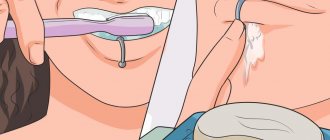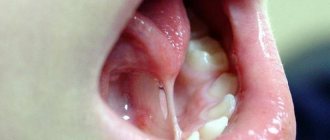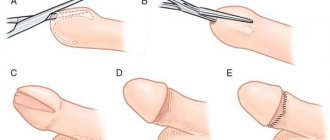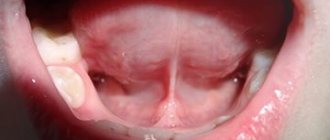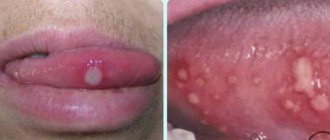What is lingual frenuloplasty?
The frenulum is a small membrane that connects the lower part of the tongue and the mucous membrane of the lower jaw. Despite its small size, it performs very important functions: it is responsible for the formation of dental occlusion, controls the mobility of the tongue and the functioning of the facial muscles.
There are three main pathologies of the tongue frenulum that require surgical correction.
- Wrong shape.
A healthy frenulum is a fold of mucous membrane in the shape of an arc. - Small size
(in medical terminology - ankyloglossia). The average length of the frenulum of the tongue in an adult is 3 centimeters; in a child it is shorter. In the case of ankyloglossia, the frenulum will not allow the tongue to be raised completely upward. - Incorrect mounting location.
A healthy frenulum is attached to the middle of the tongue, and with pathology it can be shifted to the tip.
In some cases, it becomes necessary to perform plastic surgery of the lip frenulum - the fold of mucous membrane connecting the lip and gum. The operation is performed to avoid impaired diction and the formation of malocclusion. Read more about lip frenuloplasty here.
The essence of the problem
Photo: this is what a normal frenulum looks like in a child’s mouth
The tongue is attached to the base of the mouth by its root part. Between the tongue and the lower edge of the mouth there is a small fold of skin - the frenulum. Normally, it should be such a length that a person can easily move his tongue, stick it slightly beyond the lips, touch the front surface of the teeth, and pronounce sounds.
A shortened frenulum of the tongue greatly limits its mobility, speech capabilities and ability to eat normally.
, especially in children. The same problems arise if it is not attached correctly, when it is in close proximity to the tip of the tongue.
The consequences are:
- Photo: this is what an incorrectly positioned frenulum looks like
During the period of breastfeeding, the baby is unable to suckle normally, as the tongue is limited in its movements. Because of this, children become very anxious, cry, and lose weight.
- Lack of nutrition can have a negative impact on any developing system of the body, causing stomach diseases.
- A child with a short frenulum develops an incorrect bite, which causes dental diseases and their displacement.
- After teething, when trying to stick out the tip of the tongue, the baby will injure it on the lower incisors.
- In older children, a short hyoid frenulum complicates the formation of sounds: it is difficult for them to pronounce words, and the process of learning speech is delayed.
- The breathing mechanism changes: the baby gets used to breathing through the mouth. Symptoms of the pathology
The frenulum in newborns normally has a length of about 8 mm
or more, and for five-year-old children it increases to 17. But mothers are not always able to take measurements at home, especially if the baby is very active. And only specialists can understand whether everything is located correctly in the oral cavity.
You can determine whether a child has a short frenulum by some external signs:
- In infants, due to their low ability to suck milk, loud smacking and clicking sounds appear.
- The baby attaches incorrectly to the breast, does not cover the areola with his mouth, so he often bites the nipple, which then becomes inflamed.
- The baby is nervous, arches, twists his arms and legs when feeding, often throws and applies to the breast again. Does not gain weight or even lose it.
- The tip of the tongue may be bifurcated due to shortening of the septum. What a child’s forked tongue looks like with a short frenulum, look at the photo on the right.
- Older children have noticeable speech defects, their voice is nasal and quiet.
- Saliva production increases.
- Apnea attacks are possible.
- Due to insufficient food processing, digestive problems occur.
If parents suspect a problem, they should contact their pediatrician or dentist. But in many cases, the defect is determined by a neonatologist in the maternity hospital.
Causes of tongue frenulum anomaly
Most children have mild pathology, but severe forms are also not uncommon. The size of a child’s tongue frenulum is most often determined by heredity, as well as the following factors:
- viral infection in the mother in the first and last trimesters;
- late toxicosis;
- exacerbation of chronic diseases during pregnancy;
- injuries in the abdominal area during gestation;
- taking potent drugs by the expectant mother.
Symptoms of a shortened frenulum
How to determine if your baby needs surgery? It is necessary to seek specialist advice. However, you can notice signs of a defect in the frenulum of the tongue yourself by paying attention to some details.
- The frenulum resembles a transparent film and does not have a vascular network.
- The tongue is inactive.
- The child cannot reach the upper palate with the tip of his tongue.
- When you move your tongue, clicks are heard.
- Chewing and swallowing are difficult.
- Diction is broken.
- The lower front teeth are turned towards the tongue.
When and who needs tongue frenuloplasty?
Most often, an abnormality of the frenulum of the tongue can be diagnosed in a child immediately after birth. Then it is recommended to fix it. However, plastic surgery is performed on children of preschool and school age, as well as adults. The operation is indicated in the following cases.
- Violation of sucking in newborns.
If babies have a tongue frenulum that is too short, they cannot latch onto the nipple properly, resulting in underweight, fussiness, and poor sleep. - Diction defects.
Due to poor tongue mobility, children distort some sounds, especially “r”, “l” and hissing sounds. As a rule, the problem is discovered by a speech therapist in preschool age. - Abnormal shape of teeth and gums.
A tongue frenulum that is too short can interfere with proper growth of the lower jaw. This leads to incorrect positioning of the front teeth and gum recession. - Preparation for implantation and prosthetics.
Any deviations in the shape of the soft tissue from the norm can ultimately lead to implant failure, so they need to be corrected before surgery. The discomfort caused by the pathology of the frenulum of the tongue during the use of removable dentures, especially on the lower jaw, is also important: the structures simply fall out when talking or eating.
How the research took place
Forty-one patients with overweight or severe obesity and a diagnosis of severe apnea were selected for analysis. Among them were men and women aged from 40 to 65 years. All of them had undergone uvulopalatoplasty over the past 1-5 years, but then again began to complain of snoring, respiratory arrest, and daytime sleepiness. It is characteristic that less than half of them underwent cardiorespiratory monitoring before surgery. The rest were not examined at all before surgery.
The patients were conditionally divided into groups.
| Group No. 1 | Group No. 2 |
|
|
Patients in group 2 were initially offered intraoral mouth guards or CPAP. However, for various reasons, they refused treatment and went to other clinics, where they underwent uvulopalatoplasty. Patients from the first group probably did not even suspect the existence of an alternative, because... immediately contacted an otolaryngologist.
- Group No. 1.
In all participants, cardiorespiratory monitoring confirmed severe sleep apnea. The patients suffered from excessive daytime sleepiness: four of them had cases of sudden falling asleep while driving, seven at work, and three while eating. The questionnaire revealed a low quality of night's rest with multiple awakenings, nightmares and difficulty getting up in the morning. In 18 of 22 patients, a scar deformation was found in the oropharynx, which reduced the lumen of the pharynx, that is, in fact, the goal of increasing the lumen of the airways was not achieved. - Group No. 2.
Thanks to the preoperative examination of these patients, the researchers were able to assess the dynamics of the condition of the upper respiratory tract. Uvulopalatoplasty did slightly reduce the average apnea-hypopnea index for the group. However, in not a single patient did this indicator reach the target value corresponding to the concept of health. Moreover, in 9 out of 19 people, the apnea-hypopnea index, on the contrary, increased. The surgical procedure did not affect the quality of sleep and daytime sleepiness; they remained unchanged. In most patients, cicatricial deformation of the soft palate was observed.
After the examination, patients from both groups were offered conservative methods of snoring correction. Eighteen men and women began CPAP therapy, and an additional 11 agreed to use custom mouth guards. In all those who continued treatment with conservative methods, daytime sleepiness significantly decreased and the quality of night rest increased.
What happens if tongue frenuloplasty is not performed in children?
An abnormality of the frenulum of the tongue in children provokes the following serious consequences.
- Due to a violation of the sucking regime in infancy, the child may not receive enough nutrition and, as a result, lag behind in development.
- Children with tongue frenulum abnormalities may never learn to pronounce some sounds.
- Incorrect placement of the frenulum leads to underdevelopment of the lower jaw, resulting in the formation of an incorrect bite.
If pathology of the frenulum of the tongue has been identified in a newborn, it can be easily corrected by making an incision with a laser. At this age, you won't even need stitches. With age, the structure of the frenulum becomes more complex, new vessels appear in it, so plastic surgery of the frenulum in preschool and school-age children turns into a full-fledged surgical operation. Therefore, it is best to do it at the age of 5-6 years, when the child’s milk teeth are replaced by permanent ones.
Parents can determine whether their child needs surgery on their own. To do this, ask him to reach the upper palate with the tip of his tongue. If he cannot do this, or it hurts, he should consult a doctor.
How to understand whether a tongue frenulum is short or not?
Determining frenulum shortening is quite simple even in newborns. Their feeding process is disrupted and weight loss may occur. But in some cases, incorrect attachment of the frenulum is detected in an adult.
| Signs of a shortened frenulum | Indications for surgery |
| • Restricted mobility of the tip of the tongue • The tongue curls into a tube with a clicking sound • Impaired pronunciation of certain sounds | • Quick tiredness of the mouth when chewing and talking • The area under the tongue hurts when it moves too sharply • Malocclusion • Displacement of the gums • Curvature of the smile, violation of facial proportions • Disturbance of normal breathing |
Specialists at the Smile clinic will conduct a comprehensive examination of the client and determine whether there are indications for surgery, eliminating contraindications. Doctors guarantee the safety of patients and take care of their comfort.
Operation techniques
There are two methods of performing tongue frenuloplasty: traditional (classical) and laser. This is a more modern and safer method. The laser allows the operation to be performed with great precision and does not cause bleeding after the procedure. In addition, there is no need for stitches, and healing time is significantly reduced. This is especially important if you need to perform laser frenuloplasty on a child: the baby will tolerate the procedure much easier.
Depending on what pathology of the frenulum is detected, the doctor uses one of three techniques: cuts the frenulum, removes it, or changes the attachment site. The number of cuts and their shape depend on the choice of technique.
Therapeutic exercises
There are alternative methods that allow you to do without surgery, for example, a set of special exercises for developing the frenulum of the tongue.
- Reach alternately to the upper and lower lips.
- Extend your tongue and make pendulum movements from cheek to cheek.
- Suck your tongue to the roof of your mouth and let go, imitating a horse clopping its hooves.
- Place your tongue on each cheek with your mouth closed.
- Smile with your mouth open.
- Stretch your lips.
- Pull your lips into a tube, pretending to kiss.
To achieve results, you need to perform the exercises every day for 5 - 10 minutes. It is important to remember that this method is suitable for correcting mild disorders; more severe pathologies require surgical intervention.
Price for plastic frenulum of the tongue
The cost of this procedure usually consists of the cost of consultation and examination, local anesthesia and the service itself. This is a fairly simple surgical procedure, so no additional tests are required. The price of a classic operation (with a scalpel) for adults and children is the same, but may be slightly higher if the patient has too dense frenulum tissue. Then they do not give local anesthesia, but general anesthesia; it costs more, and, accordingly, costs increase due to this. The average cost of classic lingual frenuloplasty in Moscow is 3,800 rubles. The price for laser plastic surgery of the frenulum of the tongue is about 5,000 rubles.
How to trim the frenulum under the tongue?
Trimming the short frenulum of the tongue is as follows:
- Local anesthesia
- Excision of a shortened frenulum
- Trimming the mucous membrane adjacent to the frenulum and moving it
- Suturing of the mucous membrane (when performing laser surgery, the operation is seamless)
In children, stretching the frenulum does not cause any problems. After just a couple of hours, the baby can be put to the breast. In adults, surgery is followed by a short recovery period.

